| Article ID | Journal | Published Year | Pages | File Type |
|---|---|---|---|---|
| 5398200 | Journal of Luminescence | 2016 | 7 Pages |
Abstract
Based on an aldazine-copper chemosensing ensemble (NP-Cu2+), a new fluorescence chemosensor for the detection of biothiols (Cys, Hcy and GSH) was designed and synthesized. In aqueous solution, the ligand NP exhibited high selectivity toward Cu2+ ions by forming a 2:1 complex, accompanied with a dramatic fluorescence quenching and a notable bathochromic-shift of the absorbance band. Due to the high affinity of thiols and copper, the specific interaction of thiols (Cys, Hcy and GSH) with NP-Cu2+ ensemble led to the liberation of the NP. As the result, recovery of fluorescence and UV-vis absorbance was observed. The detection limits of NP-Cu2+ to Cys, Hcy and GSH were estimated to be 1.5 μM, 1.8 μM and 2.2 μM, respectively. The fluorescence “OFF-ON” circle can be repeated to a minimum of 5 times by the alternative addition of thiols and Cu2+, implying that NP-Cu2+ is a recyclable chemosensor for thiols. Results of fluorescence microscopy imaging suggested that NP-Cu2+ has potential to be used as a powerful tool for the detection of intracellular thiols.
Related Topics
Physical Sciences and Engineering
Chemistry
Physical and Theoretical Chemistry
Authors
Yue Wang, Zhiqiang Zhang, Qingtao Meng, Cheng He, Run Zhang, Chunying Duan,
